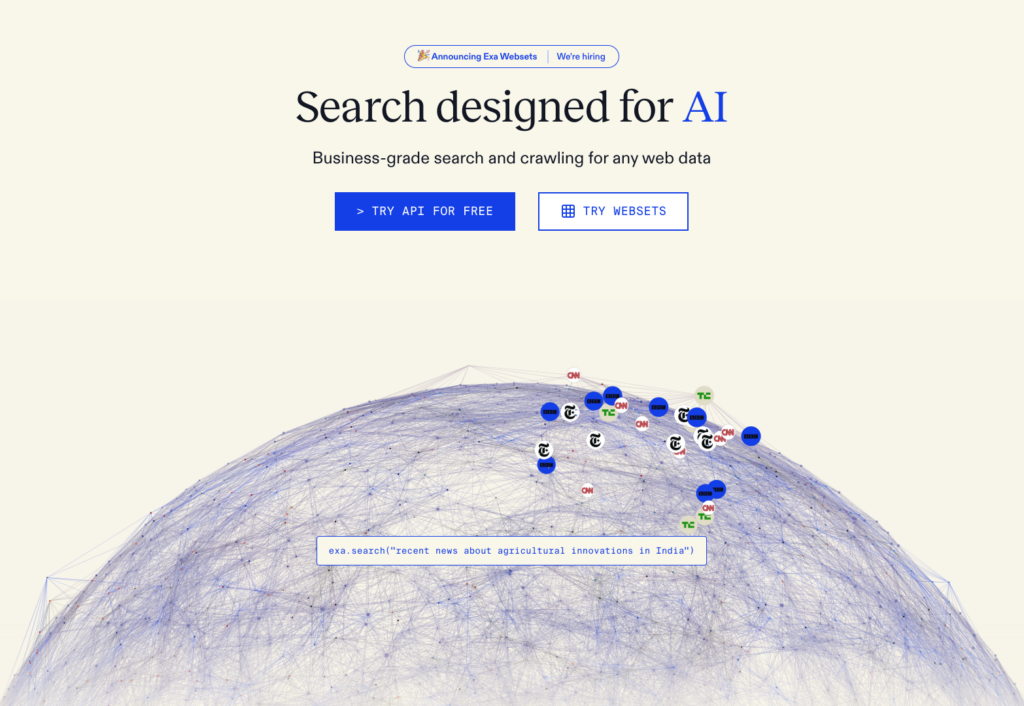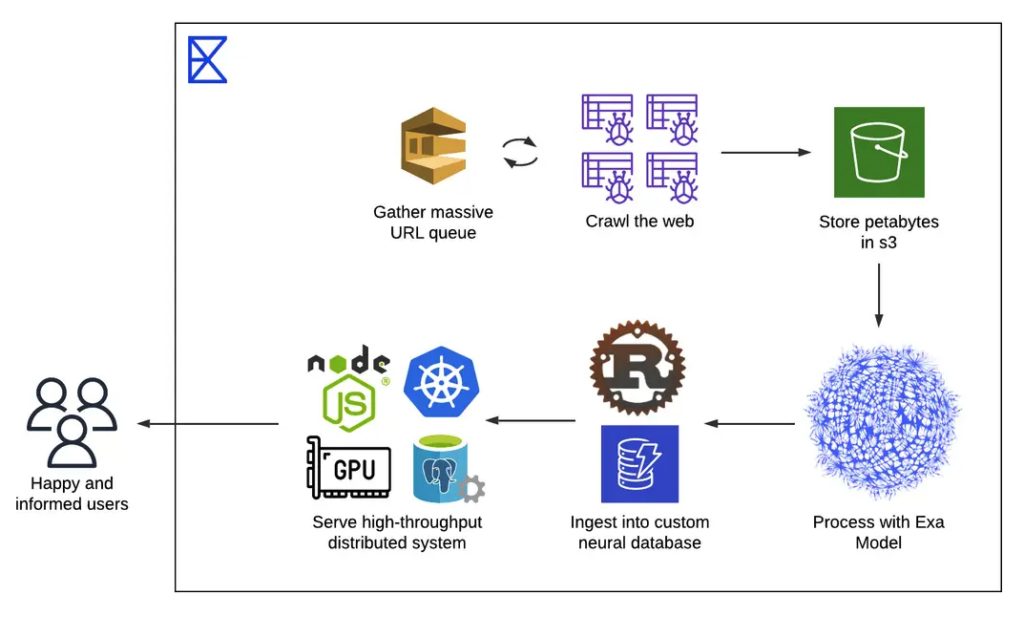Article
Exa AI is Revolutionizing Search Capabilities with LLMs

For product developers and business leaders, staying on the cutting edge of AI is crucial. One of the developments we’re most excited about at Fresh is Exa AI, a platform that leverages the superpowers of Large Language Models (LLM) to enhance search capabilities.
In this post, we’ll cover what Exa AI is, how it works, and use cases where integrating the technology makes the most sense.

What is Exa AI?
At its core, Exa AI is an AI-powered search engine. It integrates the power of LLMs, or large language models, to enhance web search and content retrieval. It does so via accessing a robust, high-quality index of web content.
One of the most valuable outcomes is moving beyond traditional keyword-based searching. Exa allows for a more intuitive and efficient AI search engine experience by understanding context and semantics.
How does Exa AI work?
Exa AI works by utilizing LLM to interpret queries more intelligently. Instead of simply matching keywords, it analyzes user intent, context, and language nuance. This results in search engine results that are relevant and highly personalized. Also, the tech evolves continuously via user interactions and machine learning, improving results over time.
Exa’s powerful search capabilities enhance user experiences with a more accurate way to search for and retrieve relevant content.

What are Exa AI’s features and functionality?
The following features and functionality highlights are summarized from several pages. Consider diving deeper with the primary sources. (Announcing Exa, Exa FAQs, Crawling Subpages with Exa, How Exa Search Works, and MIT Technology Review’s comparative deep dive on Exa AI)
1. Indexing and Data Management
- Web Crawling: Exa performs continual web crawling, building an index from encoded pages.
- Real-Time Indexing: Exa’s AI models refresh its data in real-time. This indexing capability continuously adds high-quality links and ensures up-to-date information for users.
- Content Scraping: Exa provides parsed page content to users via content scraping. The outcome is serving users with ready-to-use information.
- Curated Datasets: Exa’s artificial intelligence functionality lets users prioritize customization. Users can focus searches on web subsets via date, category, and domain filters.
2. Query Processing and Search
- Natural Language Queries: Exa understands and processes natural language queries. Users can type their questions in everyday human language instead of code. Then, Exa converts queries to machine language to produce search results.
- Query Processing: Exa uses machine learning-based neural search technology for query processing. This approach allows Exa to understand and respond to more complex searches.
- Intelligent Search: Exa’s AI models combine its neural search technology and traditional keyword search methods for intelligent search. Depending on the query, Exa automatically chooses the best search approach.
- Neural Search: Exa’s transformers are capable of discerning the semantic meaning of queries. This enables it to process complex searches effectively.
- Similarity Search: Users can find related content by providing examples. Searching via URL enables Exa’s artificial intelligence to retrieve and analyze content and improve information access.
3. Semantic Understanding and Relevance Ranking
- Semantic Understanding: Exa creates embeddings, enabled via machine learning, of encoded web pages. Exa AI captures their deeper meaning, allowing for a better semantic understanding of queries and documents.
- Relevance Ranking: Via embeddings, Exa AI improves intelligent search accuracy. It understands the meaning of text rather than just matching keywords. This relevance ranking capability predicts the most relevant links for queries.
4. Integration and Application
- API Integration: Exa AI offers a robust API that enables seamless integration of the technology with existing systems. This ensures fast, reliable, and scalable artificial intelligence search functionality.
- Knowledge Base: Exa acts as a source of current information for language models. In other words, it’s a knowledge base API for LLMs. This enhances LLMs by providing high-quality web content and reducing errors.
- Retrieval-Augmented Generation: Exa’s AI model supports advanced large language models by supplying pertinent, accurate web content. This decreases hallucination, i.e., when AI “makes things up.”
5. Data Access and Retrieval
- Web Content: Exa AI explores and indexes websites, increasing information access and web content access. Its embeddings help it grasp the overall meaning of web pages. Instead of focusing solely on keywords, the tool provides more relevant and factual data compared to traditional search engines.
- Data Retrieval: Exa AI allows users to quickly access content from its index. It also offers options for data retrieval, including links, full text, key highlights, or custom summaries.
- Information Access: Exa AI organizes online information into a comprehensive knowledge base. This supports other artificial intelligence tools; a web search API for data retrieval and content analysis.
Exa AI Use Cases
Invent Value Idea Generator: How we’ve used Exa AI at Fresh
Fresh’s proprietary collaborative innovation platform, Invent Value, employs Exa’s capabilities to help users brainstorm innovative ideas by providing contextually relevant suggestions. Specifically, the “Additional Resources” section in the platform automatically provides information retrieved by Exa based on user inputs. We refine generated ideas using this information, effectively combining the capabilities of OpenAI and Exa AI for enhanced results.
This is one example that showcases how LLM can transform the act of brainstorming and ideation, making it faster and more efficient as users explore ideas and outcomes.

Exa AI Additional Industry Applications
- Customer Support Automation: Businesses can implement Exa to streamline customer support interactions by providing relevant answers to customer queries. This automates a traditionally time-intensive workflow. It also decreases response time and increases customer satisfaction.
- Content Recommendations: E-commerce platforms can leverage Exa AI to suggest products based on users’ previous behavior and preferences. This enhances sales potential and engagement as businesses expand their digital storefronts.
- Healthcare and MedTech: Exa AI can assist in the medical field by providing professionals with the latest research and treatment options. Based on a patient’s unique conditions, Exa can provide recommendations. Providing doctors and other caregivers with relevant data strengthens their vital workflows.
- Financial Industry Applications: In the financial industry, Exa AI can be leveraged for a range of uses cases. The technology can improve customer service, integrating natural language processing into virtual assistants. It also enables enhanced search capabilities for employees. Accessing and analyzing vast financial data, market information, and customer records can be easier with Exa. As banks and credit unions embrace branch transformation, move toward smart branch models, and adopting innovative approaches like open banking, tools like Exa AI will prove invaluable.
- Logistics Industry Applications: In the logistics industry, Exa AI applies to a vast range of use cases. From demand forecasting to supply chain visibility, in-store dynamic pricing, and route optimization, the use cases are numerous.

Future Considerations
As exciting as Exa’s artificial intelligence capabilities are, there are a few important factors to keep in mind for adoption.
First, implementation may require an adjustment period as teams adapt to the new tech. Considering the sensitivity of data security and privacy is important to consider. Financial and healthcare data regulations, for example, are critical to understand. For some use cases, such as highly technical or niche questions, Exa might not yield the desired results due to limitations in the underlying dataset.
Implementation Time and Effort
Implementing Exa AI within existing systems is a manageable but highly strategic endeavor. The time and effort involved depend on technology infrastructure complexity and app complexity. However, many businesses can see initial results soon after implementation. Ongoing optimization, fine-tuning, and adaptation can increase the value of implementing Exa exponentially.
Embracing the potential of Exa AI
Understanding Exa AI’s potential can be a game-changer for product and business leaders. By embracing LLM technologies, organizations can significantly enhance their search capabilities. The benefit is improving user experiences and enabling greater efficiency.
If you’re interested in exploring how to leverage Exa in your products and workflows, let’s connect!









